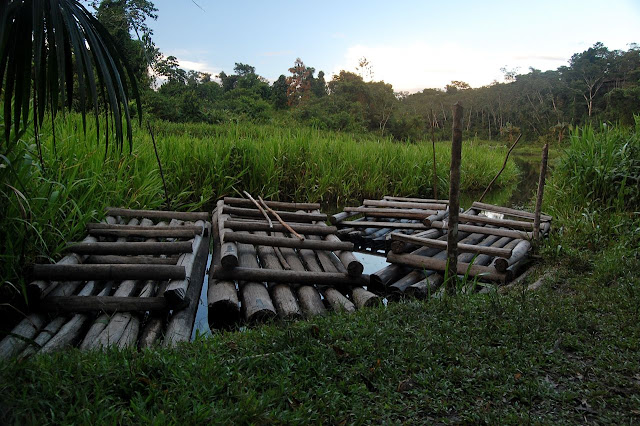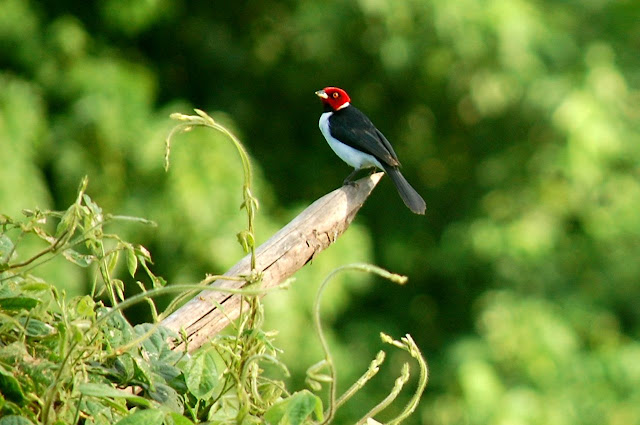On day three of our Amazon Jungle adventure we set out for an afternoon excursion to Machu Huasi Oxbow Lake, where–among other animals–we saw capybaras, the largest living rodents in the world. At 35 to 66 kg (77 to 150 lb.) of weight, they are fifty times heavier than their close cousin–the guinea pig. Despite their large size, it is surprisingly difficult to see them in the wild. These semi-aquatic mammals spend most of their lives underwater, and can keep their breath for quite a long time. They seem to be shy as well, and did not want to be photographed. We managed to catch a few glimpses of one or two capybaras when they came to the surface to catch some air, but there was not enough time to snap a good photo. The only shot that I managed to take is completely blurred and could equally well be a photo of a Loch Ness monster.
Machu Huasi is not only home to capybaras, but also to many exotic birds. The most interesting of them was a colorful and noisy bird by the name of hoatzin. Like the capybara, the hoatzin is also endemic to South America. The hoatzin is quite large (0.65 meters/2 feet), has a long neck, and has a small head topped with a spiky crest. It’s pleasant on the eyes with its blue face and maroon eyes, but it is not the primary reason why I found it fascinating. I was intrigued to learn that the funky-looking hoatzin is interesting from the evolutionary point of view as well: its DNA suggests that it is one of the oldest birds on earth.
Its anatomy is also enthralling: similar to a cow, and unique among other birds, the hoatzin uses bacterial fermentation to break down the leaves and buds it consumes. Unlike the cow, however, which possesses the rumen–a specialized stomach for bacterial fermentation–the hoatzin uses the crop–an enlargement of the esophagus. In fact, the hoatzin’s crop is so large that it displaces the flight muscles, impairing its flight capacity. Adult birds can fly only short distances, and look rather clumsy.
Hoatzins are also quite vocal and use a variety of hoarse calls, including groans, hisses, and grunts, to communicate with other individuals in their group. Their calls are loud and often associated with body movements, such as wing spreading. It’s quite a spectacle to watch them “talk” to each other.
A different kind of attraction that we experienced during our Machu Huasi Oxbow Lake excursion was using a balsa raft to navigate the lake. It is a perfect means of transport to use there, as it can move quietly and slowly, without disturbing the birds. Floating on the lake, quietly scanning the trees and grass in search of the birds, we felt connected with nature like never before.
Our excursion to Machu Huasi Oxbow Lake started with a small mishap–neither of the two boats that were at our disposal would start. As a likely reason for that was flooding of their engines, our guides tried to remove as much water from the boats as possible. Seeing how much water was in the boat made me worried that it might sink … Luckily that didn’t happen.
After we disembarked the boat, we had to walk for about 30 minutes before we got to Machu Huasi Oxbow Lake.
We didn’t mind that at all, as along the way we saw many interesting animals and plants. My favorite was Mimosa pudica (a.k.a. Sensitive Plant, Touch-me-not, Humble Plant, Shame Plant), which folds it leaves when touched or shaken.
A video:
We saw several other interesting animlas and plant as well.
Machu Huasi is not only home to capybaras, but also to many exotic birds. The most interesting of them was a colorful and noisy bird by the name of hoatzin. Like the capybara, the hoatzin is also endemic to South America. The hoatzin is quite large (0.65 meters/2 feet), has a long neck, and has a small head topped with a spiky crest. It’s pleasant on the eyes with its blue face and maroon eyes, but it is not the primary reason why I found it fascinating. I was intrigued to learn that the funky-looking hoatzin is interesting from the evolutionary point of view as well: its DNA suggests that it is one of the oldest birds on earth.
Its anatomy is also enthralling: similar to a cow, and unique among other birds, the hoatzin uses bacterial fermentation to break down the leaves and buds it consumes. Unlike the cow, however, which possesses the rumen–a specialized stomach for bacterial fermentation–the hoatzin uses the crop–an enlargement of the esophagus. In fact, the hoatzin’s crop is so large that it displaces the flight muscles, impairing its flight capacity. Adult birds can fly only short distances, and look rather clumsy.
Hoatzins are also quite vocal and use a variety of hoarse calls, including groans, hisses, and grunts, to communicate with other individuals in their group. Their calls are loud and often associated with body movements, such as wing spreading. It’s quite a spectacle to watch them “talk” to each other.
A different kind of attraction that we experienced during our Machu Huasi Oxbow Lake excursion was using a balsa raft to navigate the lake. It is a perfect means of transport to use there, as it can move quietly and slowly, without disturbing the birds. Floating on the lake, quietly scanning the trees and grass in search of the birds, we felt connected with nature like never before.
Our excursion to Machu Huasi Oxbow Lake started with a small mishap–neither of the two boats that were at our disposal would start. As a likely reason for that was flooding of their engines, our guides tried to remove as much water from the boats as possible. Seeing how much water was in the boat made me worried that it might sink … Luckily that didn’t happen.
After we disembarked the boat, we had to walk for about 30 minutes before we got to Machu Huasi Oxbow Lake.
We didn’t mind that at all, as along the way we saw many interesting animals and plants. My favorite was Mimosa pudica (a.k.a. Sensitive Plant, Touch-me-not, Humble Plant, Shame Plant), which folds it leaves when touched or shaken.
A video:
We saw several other interesting animlas and plant as well.















